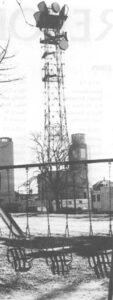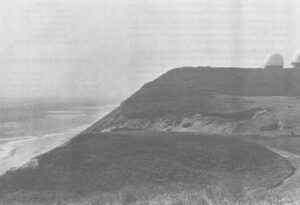In a classic demonstration of constitutional democracy in action, groups of citizens on Cape Cod and in California have confronted the Air Force over the safety of some giant radars being installed on the east and west coasts of the United States. Starting independently in the spring and summer of 1977, the twin protests proceeded from informal exchanges of information between people concerned about the health hazards of microwave radiation emitted by radar, to involvement with various environmental organizations, to the enlisting of support from members of the medical and scientific community. A ripple of inquiry then traveled up through the social and political structure of the nation as efforts to alert town, county, and state officials were followed by letters to congressmen and senators, who, in turn, sent letters expressing concern to influential colleagues, to regulatory agencies, and to the Department of Defense.
The momentum and pressure generated by all of this finally paved the way for a series of question-and answer meetings between citizens’ groups and representatives of the Air Force. These meetings received extensive news coverage and helped to educate the public and to solidify public opinion. They also set the stage for court action against the Air Force, as well as for a legal challenge of the government’s present recommended level of exposure to microwave radiation. This level is ten thousand times higher than the exposure standard recommended for the civilian population in the Soviet Union and in other Eastern European countries, and it is considered grossly inadequate by a growing number of American scientists and researchers.
A cause celebre over microwaves has been building since the State Department’s belated admission, in February 1976, that its employees at the Moscow Embassy had been routinely exposed to low-level microwave radiation for many years, and its equally belated decision to perform a retrospective study of their health experience. Coming investigations of the problem will undoubtedly extend far beyond the hazards of diplomatic service and of military radar, for in this electronic age microwave and radio frequency radiation are given off by an awesome range and number of devices, including airport and weather radars, radio and television transmitters, medical diathermy machines, cooking ovens, citizens’ band radios, shoplifting and burglar alarms, and a wide variety of industrial furnaces and heating systems. For the moment, however, a major part of the focus will surely remain upon the Department of Defense, which is by far the largest user of microwave radiation in the country.
As for the Air Force, it has reacted to both public and congressional inquiry with evasion and deception. In so doing, however, the Air Force may have unwittingly supplied a giant crowbar to those who wish to pry open the massive cover-up of the microwave radiation hazard that has been orchestrated by the powerful military-electronics industry complex over the past twenty years. Indeed, in addition to revealing a possibly critical public health problem, a thorough investigation of microwaves promises to point up the growing necessity for stronger civilian control of the military.
Nowhere can the need for such control be seen more clearly than in the Air Force’s blatant attempts to con the public about the PAVE PAWS radars now being set up at Otis Air Force Base on Cape Cod, and at Beale Air Force Base, in California. PAVE PAWS stands for Precision Acquisition of Vehicle Entry Phased Array Warning System. Unlike conventional radar with its large rotating antenna, phased array radar employs an array of thousands of small antennas, called radiating elements, which are individually controlled by computer to form a single beam that may be steered electronically and very rapidly in a large number of directions. PAVE PAWS contains 3,600 radiating elements mounted on two angled facades of a six-story, 105-foot-high reinforced concrete structure. According to the Air Force, microwave beams emanating from PAVE PAWS will scan a 240’ arc over the Atlantic and Pacific Oceans; they will be able to track hundreds of objects simultaneously, and can detect car-sized objects at a distance of 3,000 miles. Not surprisingly, the primary mission of the radar will be to detect and warn of sea-launched ballistic missile (SLBM) attack upon the continental United States.

“In the past five months, I have become aware of a great many research efforts in this area, and I have also learned that there is great debate within the scientific community over the long-term effects of low-level radiation like that which PAVE PAWS will emit. As a result, no one today can say with certainty that long-term exposure to such low-level radiation will not be harmful. Because it is a matter of such uncertainty, and because there is no question that some extremely low-level radiation will exist in populated areas immediately adjacent to Otis Air Force Base, I feel strongly that the burden of further proving that radiation from PAVE PAWS will not jeopardize the health of Cape Codders-not only today but 20 years from now-should fall upon the Air Force, rather than upon those who are concerned about the potential health hazards of such a project.
Studds went on to say that he had requested the Air Force to document the research it had used to determine that long-term exposure to low-level microwave radiation would not endanger the health of Cape Codders. “If the Air Force cannot justify the PAVE PAWS construction with this type of information,” he wrote, “then I will request that all testing of the PAVE PAWS installation be postponed until the Air Force adequately addresses this problem in a fully documented Environmental Impact Statement.” After stating that the trend toward unchecked, ever-growing dependence upon microwave radiation should be halted until its biological consequences are understood, Studds posed a direct challenge to the military-industrial complex that Dwight Eisenhower had warned the nation about twenty years ago. “By questioning the safety level of PAVE PAWS, we have an opportunity to begin a slow reversal of this trend, and a chance to send a message to both military and industrial officials in this country that we no longer intend to stand by idly while the amount of radiation continues to soar,” he said. “We must, I believe, begin to demand proof from the military and business interests that their actions today will not endanger our health twenty years from now. The burden of proof clearly lies on their shoulders.”
As things turned out, this burden proved far too heavy for Air Force radar experts who, at the invitation of several Cape Cod environmental groups, appeared that same week at public forums in North Truro and Sandwich. Each of the meetings lasted about three hours, and they were attended by a total of some 800 Cape Cod residents from all walks of life. (For example, the audience at North Truro included fishermen, artists, housewives, and half a dozen physicians, as well as Professor George Wald, a Harvard biologist who shared the 1967 Nobel Prize in Medicine.) Many of the people had taken the trouble to inform themselves about studies showing that microwaves can cause genetic damage, and can also affect the eyes, the heart, the brain, and the blood-forming system. Most of the questions, therefore, dealt with the health effects of microwaves, and for the most part they were directed in courteous but relentless fashion to Mr., John C. Mitchell, a physicist from the Radiation Sciences Division of the School of Aerospace Medicine, who had been sent by the Surgeon General of the Air Force.
From start to finish, Mitchell and Colonel McEachern, the director of the PAVE PAWS Program, tried to maintain that the Air Force had taken a “conservative approach” toward the possible biological hazards of microwave radiation. In the end, they were simply overwhelmed by evidence to the contrary. Among the questions for which they either had no answers, or obviously inadequate answers, were the following:
Why are recommended levels for civilian exposure to microwaves ten thousand times lower in Russia and other European countries than in the United States?
Why is the State Department funding a major study of the health experience of its Moscow employees, who have been exposed to lower levels of microwave radiation than those found on Cape Cod?
What studies have been performed to prove that routine exposure to low levels of radiation on Cape Cod pose no hazard to human health?
What about studies showing that extremely low levels of radiation with the same frequency and characteristics as the radiation from North Truro and PAVE PAWS can alter the function and the chemistry of the brains of test animals?
As for the Air Force’s conservative approach, one medical doctor informed Mitchell and his colleagues that a truly conservative approach would rule out any exposure to levels of radiation that had been shown to produce biological effects in test animals. Another doctor declared that unless the Air Force could assure the people who lived in the area that exposure to the radar beams was absolutely safe for their health, “I as a physician want to recommend that the exposure be stopped.” A pediatrician from Children’s’ Hospital in Boston warned that to irradiate the human population without knowing the biological consequences was not only contrary to every concept of preventive medicine, but constituted the “grossest malfeasance in public health.” Professor Wald pointed out that the recommended government standard upon which the Air Force based its claim of conservatism was itself based upon the irrelevant and incorrect assumption that the harmful effects of microwaves were limited to the heating of tissue.
And so it went.
Toward the end of the Truro meeting, a woman, who had clearly heard enough, went to a microphone, looked at the Air Force representatives, and asked in an exasperated tone, “If you are our protectors, who is going to protect us from you?”
The next evening, in Sandwich, another woman asked Mitchell if he could guarantee the safety of her two children from the effects of radiation from PAVE PAWS.
After stating his belief that the levels would be safe, Mitchell replied that he was not going to guarantee her anything.
“Then I ask you,” she countered, “who is my enemy?”
At that point, one could almost feel sorry for Mitchell and McEachern, who had begun to show signs of weariness. After all, they were decent, ordinary men, who were simply doing their duty. No one had expected them to come on as heroically sensitive as the Air Force officer played by Gregory Peck in “Twelve O’clock High.” Or, for that matter, as weird and edgy as the patently neurotic general played by Sterling Hayden in “Dr .Strangelove.” The trouble was, they looked like puzzled salesmen whose pitch had been unexpectedly rejected. And that was why there was something scary about them. What was scary was that they were standing up there, trying to sell people on PAVE PAWS as if it were truly benign, even good for you, like toothpaste.
By this time, it was obvious that the Air Force had made a serious miscalculation in its handling of the PAVE PAWS affair. The Air Force had figured to stick the radar on the best available piece of real estate, tell the locals it would be good for business, assure the Audubon Society that it would be okay for birds, and let everybody think it would only be used to zap the wild blue yonder. However, the meetings in North Truro and Sandwich changed all that. By the end of January, the environmental groups that had sponsored the meetings had formed a coalition, retained a lawyer, and started raising money to file suit requiring the Air Force to prepare an environmental impact statement. At the same time, Senator Edward M. Kennedy and Senator Edward W. Brooke of Massachusetts followed the lead of Congressman Studds and wrote tough letters about the radiation hazard to Secretary of the Air Force John C. Stetson. Kennedy wanted to know if there had been “any definitive studies on the biological effects of long-term, low-trade microwave radiation on the general public residing in the vicinity of installations similar to the North Truro or to the Otis radar sites.” He then asked Stetson a question that must be driving Air Force radar experts up the wall. “Specifically,” he wrote, “do you know what biological effect these levels of radiation have on pregnant women, the elderly, or persons afflicted with heart disease?”
As for Senator Brooke, he fired off a letter to Stetson suggesting that the Secretary read up on the effects of microwaves upon the brain, and questioning “whether it is wise to proceed with PAVE PAWS at this time.” Brooke told Stetson that the Air Force should prepare a complete environmental impact statement for PAVE PAWS, and stated his belief that if it showed PAVE PAWS posed a real danger to Cape Cod, “the Air Force would have to seek an alternative site for the radar system.”
A few days later, an Air Force spokesman informed Brooke that the School of Aerospace Medicine was preparing a special report on the long-term effects of low-level microwave radiation. It soon turned out that what the Air Force had in mind was a lengthy review of the medical literature in which the salient studies of low-level biological effects would surely be submerged in the sea of inappropriate research that had been funded by the military for more than twenty years, in order to “prove” the fallacious notion that the only hazards associated with microwaves were thermal. Brooke then released a statement saying that “The Air Force’s reluctance to initiate an environmental impact statement immediately and to answer all of the legitimate questions posed by Cape Cod residents is inexcusable.”
Behind the delaying tactics lurks the nagging suspicion that the Air Force may be trying to hide more than information about the biological effects of low-level radiation. Indeed, good reason for thinking so comes from California, where some residents of Yuba County filed suit to halt construction of the PAVE PAWS at Beale AFB last August. Just prior to a scheduled hearing in Federal District Court, in Sacramento, the Air Force offered to settle the suit by guaranteeing that emissions from the radar would not exceed certain levels. (The Air Force obviously wanted to avoid a court fight for the same reason it wants to avoid writing an environmental impact statement; either way it would be forced to answer questions about the microwave hazard for which it has no answers.) However, negotiations for a settlement soon broke down when the Air Force refused to agree to the plaintiffs’ demand that radiation levels from PAVE PAWS be continuously monitored.
Senator Alan Cranston of California has recently written Secretary Stetson asking why the Air Force refused to agree to continuous monitoring. The answer could well be that the Air Force has been something less than candid about the elevation angle of the main beam of PAVE PAWS. In its environmental assessment of March 1976, the Air Force maintained that the beam would not operate below three degrees above the horizon. The assessment went on to say that the main beam “will never be allowed to radiate along the ground or to illuminate obstructions.” During the public meetings at North Truro and Sandwich, Air Force representatives reiterated this claim on several occasions, giving the clear impression that the main beam would be pulsing out far above everyone’s head.
Whether the Air Force is to be believed in this matter is open to question. For example, the Raytheon Company’s contract specifications for PAVE PAWS, which are dated September 3, 1976, nearly six months after the environmental assessment was released, state that the main beam of the radar can be adjusted within eight seconds “to any operator-selected configuration from zero degrees (horizon) to ten degrees in elevation. . . ” In fact, not until September 1977, when faced with the prospect of going to court, did the Air Force modify the contract with Raytheon and limit the elevation angle of the main beam to three degrees.
All of this raises further questions. Why did the Air Force seek to deceive the public about the elevation of the main beam in the first place? Is the recent modification of the contract for real, or just a ruse to conceal the fact that the Air Force intends to operate the main beam at zero degrees in any case? And would such an intention not provide a perfect explanation for the Air Force’s refusal to agree to continuous monitoring of the radiation emanating from PAVE PAWS?
Whether these and other questions about PAVE PAWS will be answered depends upon investigations yet to be launched by Congress, and by action still to be taken in federal courts. Meanwhile, the Air Force appears to be hell-bent on stonewalling everybody in sight, including the kids. Just the other day, before allowing Colonel McEachern to appear before the student body of the high school, in Falmouth, Massachusetts, the Air Force stipulated that the colonel would not be able to respond to any questions about the validity of the present government standard for microwave radiation, or about the long-term health effects of exposure to microwave radiation.
Received in New York on March 3, 1978
Paul Brodeur, a freelance writer and contributor to The New Yorker, is an Alicia Patterson Foundation award winner. He is also the author of The Zapping of America. His fellowship subject is on examination of how the nation reacts to the health hazard posed by microwave radiation. This article may be published with credit to Mr. Brodeur as a Fellow of the Alicia Patterson Foundation. The views expressed by the author in this newsletter are not necessarily the views of the Foundation.




